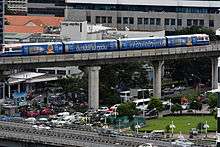Transport in Thailand
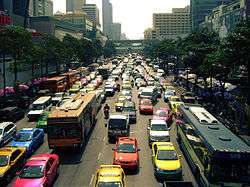
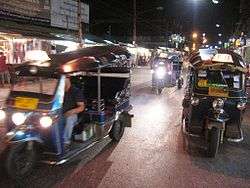
Transport in Thailand is varied and chaotic, with no one dominant means of transport. For long distance travel, bus transport dominates. Low-speed rail travel has long been a rural long-distance transport mechanism, though plans are underway to expand services with high-speed rail lines extending to several major regions of Thailand. Road transportation is the primary form of freight transport across the country.
For short trips motorbikes are common. There are public motorcycle taxis in Bangkok, Pattaya, and other large cities. An overwhelming number of taxis can also be found in Bangkok. Since the country's first rapid rail transit line opened in 1999 in Bangkok, daily ridership on Bangkok's various transit lines has risen to over 800,000, with multiple additional lines either under construction or being proposed.
Private automobiles, whose rapid growth contributed to Bangkok's notorious traffic congestion over the past two decades, have risen in popularity, especially among tourists, expats, the upper class, and the growing middle class. A motorway network across Thailand has been gradually implemented, with motorways completed in Bangkok and most of central Thailand.
Domestic air transport, which had been dominated by a select few air carriers, saw a surge in popularity since 2010 due in large part to the expanding services of low cost carriers such as Thai Air Asia and Nok Air.take people door to door.
Areas with navigable waterways often have boats or boat service, and many innovative means of transport exist such as tuk-tuk, vanpool, songthaew, and even elephants in rural areas.
Rail transport

The State Railway of Thailand (SRT) operates 4,070 km of 1.000 m gauge railway line (372.63 km double track and 106.01 km triple track).
The SRT operates all of Thailand's national rail lines. Bangkok Railway Station (Hua Lamphong Station) is the main terminus of all routes. Phahonyothin and ICD Lat Krabang are the main freight terminals.
The SRT has long been popularly perceived by the public as inefficient and resistant to change. Trains are usually late, and most of its equipment is old and poorly maintained. The worst financially performing state enterprise, the SRT consistently operates at a loss despite being endowed with large amounts of property and receiving large government budgets; it reported a preliminary loss of 7.58 billion baht in 2010.[1] Recurring government attempts at restructuring and/or privatization throughout the 2000s have always been strongly opposed by the union and have not made any progress.[2][3]
There are two active rail links to adjacent countries. The line to Malaysia uses the same 1,000 mm (3 ft 3 3⁄8 in) gauge, as does the line to Laos across the Mekong River on the Thai-Lao Friendship Bridge. The line to Cambodia is currently disused and is being rebuilt, while the line to Myanmar is defunct (see Death Railway). A projected extension will rebuild the route[4] and in 2011 a link was also proposed from Kanchanaburi to Port Dawei.
Rail transport in Bangkok includes long-distance services, and some daily commuter trains running from and to the outskirts of the city during the rush hour, but passenger numbers have remained low. There are also three rapid transit rail systems in the capital.
Rail rapid transit systems

Bangkok Metropolitan Region
Bangkok is served by three rail rapid transit systems:
- MRT, with two lines.
- Bangkok Skytrain or BTS, with two lines.
- Suvarnabhumi Airport Link or ARL, with one line.
Khon Kaen
In March 2016, the Thai government approved the first LRT project in Khon Kaen province, to be built by the private sector. The first phase of the project will be a 26 km North-South route. Previously, this corridor was intended to be served by a bus rapid transit route. The Office of Transport and Traffic Policy (OTP) will fund a 8-month project study for Khon Kaen University with 38 million baht. The Khon-Kaenpattanmong or Khon Kaen Think Tank, a private company, will be the main investor in the project and responsible for the operation of the network. The project is expectedto begin construction in 2017 for completion within 1–2 years. The Phase 1 budget is estimated at 1.5 billion baht.[5]
Other Provinces
Several other rapid transit systems have been proposed but have not been approved as of 2016: Chiangmai Monorail, Pattaya LRT, Phuket LRT and Hat Yai Monorail.
Road transport
As of 2006 the Thai road network consisted of 180,053 km of roads, 98% paved.[6] According to the World Health Organization, Thailand's roads are the second deadliest in the world.[7]
Public bus service
Buses are a major method of transportation for people, freight, and small parcels, and are the most popular means of long distance travel. Tour and VIP class long-distance buses tend to be luxurious, while city- and other-class buses are often very colorful with paint schemes and advertising.
There are fundamentally two types of long-distance buses in Thailand:
- those run by The Transport Company, Ltd., (TCL), the state-owned bus company.[8] Known to Thais by the initials บขส (pronounced baw-kaw-saw), this 80-year-old company was formed by the government to ensure that citizens in even the most far-flung localities had access to the capital city, Bangkok. TCL buses are easily identified by the large golden coat of arms appliqued to each side of the bus.
- those operated by private bus companies. These are too numerous to list and offer hundreds of routes in various service categories (express, VIP, local, air conditioned, etc.)
Public bus service in Bangkok
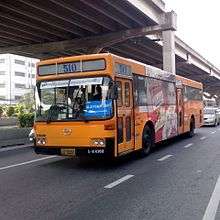
In Bangkok, the Bangkok Mass Transit Authority or BMTA, is the main operator of public transit buses within the Greater Bangkok area. The Bangkok Mass Transit Authority offers bus and van routes throughout the city and its suburban provinces. Many bus routes in Bangkok are served by several private companies, sometimes duplicating those from BMTA. Examples include orange minibuses, and cream-blue buses. The buses have the BMTA symbol on them, mostly seen below the driver's side window. These often follow slightly different routings from the main big BMTA bus or do not run along the whole route.
BMTA currently operates bus routes in Bangkok and its metropolitan area namely Nonthaburi, Pathum Thani, Samut Prakan, Samut Sakhon and Nakhon Pathom.
Local buses and Bangkok city buses come in various sizes, types, and prices, from half size, full size, double length, open window, fan, and air conditioned.
Bus rapid transit system in Bangkok
The Bangkok BRT is a bus rapid transit system in Bangkok. Of five routes that were originally planned, only one line has been operating since 2010. The 16 kilometres (9.9 mi) route has twelve stations in the centre of the road that give at-grade access to the right-hand side of the buses. Both termini connect to the Silom Line of the BTS Skytrain; at Chong Nonsi (S3) and Talat Phlu (S10). The buses used are all Sunlong SLK6125CNG buses. The flat fare is 5 baht.
Highway network
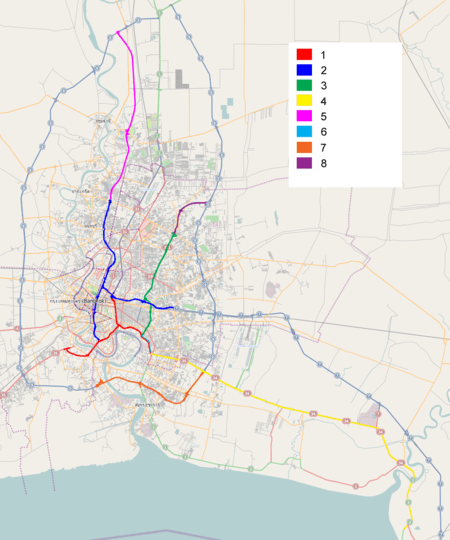
The Thai highway network links every part of Thailand. Most highways are in good state of repair, greatly enhancing safety and speed. The four-lane highways often have overhead concrete pedestrian crossings interspersed about every 250 meters in populated areas. There are few on and off ramps on eight-lane highways, most highways are separated by medians with breakage for U-turns, except on major roads where ramp style U-turns predominate.
A number of undivided two-lane highways have been converted into divided four-lane highways. A Bangkok - Chon Buri motorway (Route 7) now links to the new airport and Eastern Seaboard.
Motorway network
The Thai motorway network is small. Coupled with Bangkok's extensive expressway network, the motorways provide a relief from regular traffic in Bangkok. The Thai Government is planning infrastructure investment in various "megaprojects", including motorway expansion to approximately 4,500 kilometers.
Expressway network
Thailand uses the expressway term for the toll road or highway network. Most expressways are elevated with some sections at ground level. The current expressway network covers major parts of Bangkok and suburban areas. Expressways are used to avoid heavy traffic jams in Bangkok and reduce traffic time but are sometimes congested in rush hour.
Alternative transport
Other forms of road transport includes tuk-tuk, taxi, van (minibus), motorbike taxi and songthaew.
There are 4,125 public vans operating on 114 routes from Bangkok to the provinces alone. They are classed as Category 2 public transport vehicles (routes within 300 kilometres). Until 2016, most operated from a Bangkok terminus at Victory Monument. They are being moved from there to the Department of Land Transport's three Bangkok bus terminals.[9]
Air transport
Airports
- Main article: List of airports in Thailand and Busiest airports in Thailand
As of 202, Thailand had 103 airports with 63 paved runways, in addition to 6 heliports. The busiest airport in the county is Bangkok's Suvarnabhumi Airport.
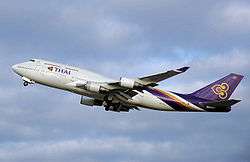

Major international airports
- Suvarnabhumi Airport (BKK) (New Bangkok International Airport, a major international hub)
- Don Mueang International Airport (DMK) (Old Bangkok International, now used mostly by low-cost carriers)
- Chiang Mai International Airport (CNX)
- Mae Fah Luang International Airport (CEI)
- Hat Yai International Airport (HDY)
- Phuket International Airport (HKT)
- Krabi International Airport (KBV)
- Samui International Airport (USM)
- Surat Thani International Airport (URT)
- Udon Thani International Airport (UTH)
- U-Tapao International Airport (UTP)
Airlines
- Main article: List of airlines of Thailand
The national carrier of Thailand is Thai Airways International, founded in 1959. Bangkok Airways has been operating since 1968 and now markets itself as "Asia's Boutique Airline". Low-cost carriers have become prevalent since 2003, including Thai Airways' Thai Smile, Thai AirAsia and Nok Air.
Water transport

As of 2011 there were 3,999 km of principal waterways, of which 3,701 km had navigable depths of 0.9 m or more throughout the year. There are numerous minor waterways navigable by shallow-draft native craft, such as long-tailed boats.
River and canal transport
In Bangkok, the Chao Phraya River is a major transportation artery, with ferries, water taxis (the Chao Phraya Express Boat) and long-tailed boats. There are local, semi-express, and express lines for commuters, though the winding river means trips can be much farther than by bus. There is also the Khlong Saen Saeb boat service, which provides fast, inexpensive transport in central Bangkok.
Ferries
Ferry service between hundreds of islands and the mainland is available, as well as across navigable rivers, such as Chao Phraya and Mae Khong (Mekong). There are a number of international ferries.
Sea transport
In Thailand, the Gulf of Thailand and Andaman Sea is a transportation system:
- Trat - Ko Chang boat service
- Surat Thani - Ko Samui boat service
- Phuket - Phi Phi Islands boat service
- Bang Pu - Hua Hin - Pranburi boat service
- Bang Pu - Pattaya boat service
- Pattaya - Hua Hin - Pranburi boat service
Ports and harbors
Merchant marine fleet
As of 2010 Thailand's merchant marine fleet consisted of 363 ships (1,000 GRT or over) totaling 1,834,809 GRT/2,949,558 tonnes deadweight (DWT). By type this includes 31 bulk carrier, 99 cargo ships, 28 chemical tankers, 18 container ships, 36 liquified gas vessels, 1 passenger ship, 10 passenger/cargo ships, 114 petroleum tankers, 24 refrigerated cargo ships, 1 roll-on/roll-off, 1 other passenger vessel.
Pipelines
Pipelines are used for bulk transport of gas (1,889 km as of 2010), liquid petroleum (85 km) and refined products: (1,099 km).
See also
References
- ↑ Chantanusornsiri, Wichit (23 January 2012). "State railway to finally account for assets and liabilities". Bangkok Post.
- ↑ Mahitthirook, Amornrat; Marukatat, Saritdet (22 December 2010). "Getting on track needs strong political will". Bangkok Post.
- ↑ Bowring, Philip (23 October 2009). "Thailand's Railways: Wrong Track". Asia Sentinel. Asia Sentinel. Retrieved 22 August 2012.
- ↑ "Neighbours to the west get closer | Bangkok Post: news". Bangkok Post. 2012-02-28. Retrieved 2012-08-13.
- ↑ http://www.posttoday.com/biz/gov/421979
- ↑ "The World Factbook — Central Intelligence Agency". www.cia.gov. Retrieved 2016-10-06.
- ↑ PCL., Post Publishing. "Thailand's roads second-deadliest in world, UN agency finds". http://www.bangkokpost.com. Retrieved 2016-10-06. External link in
|newspaper=(help) - ↑ "Home". The Transport Co., Ltd. Retrieved 2015-01-10.
- ↑ Mahittirook, Amornrat (7 November 2016). "Public vans likely to offer 10% fare cut". Bangkok Post. Retrieved 7 November 2016.
External links
| Wikimedia Commons has media related to Transport in Thailand. |
- 2bangkok.com - Transportation developments and events.
- Thailand Transportation Modes - Transportation modes.
- Long distance travel and public transport info - Departure stations in Bangkok and timetables.
- Online bus tickets, along with ferry, railways, and city transport timetables in Thailand
- Thai national bus company
- Railway map
- Thailand Accident Research Center (TARC) - Road & Transportation Safety.
- Driving in Thailand - Driving a car in Thailand and how to get a drivers license.
- Transport photo in Thailand
![]() This article incorporates public domain material from the CIA World Factbook website https://www.cia.gov/library/publications/the-world-factbook/index.html.
This article incorporates public domain material from the CIA World Factbook website https://www.cia.gov/library/publications/the-world-factbook/index.html.

